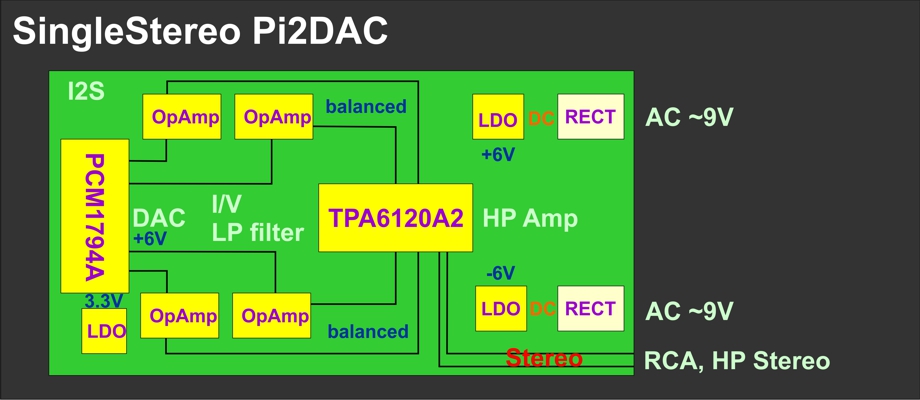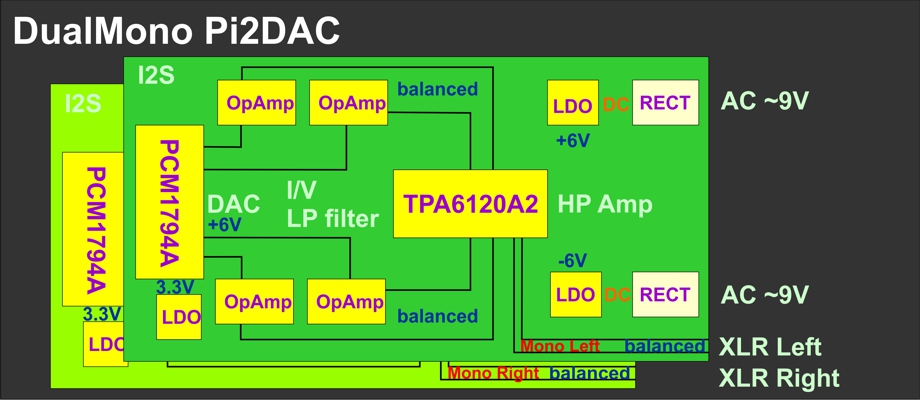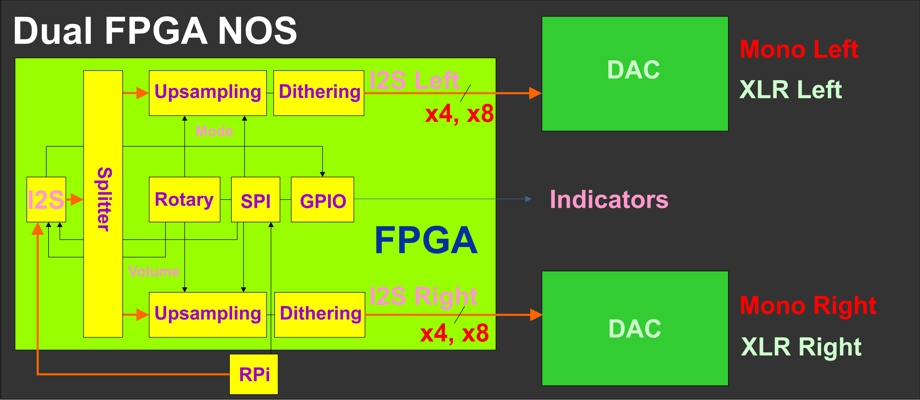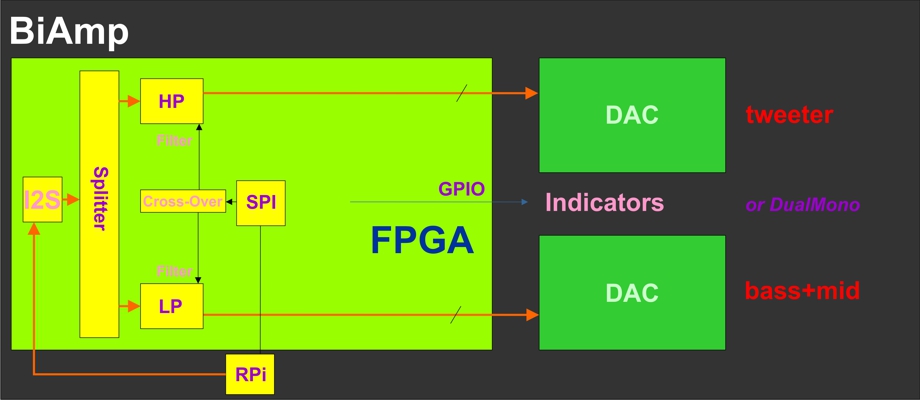Lyrebird Pi2DAC Details
The Lyrebird Pi2DAC is based on the TI PCM1794A. It can be a cap-less system (no capacitors in signal path, except in LP filter (LP) feedback, optional). I tried to run without LP cap: works, treble gets quite sharp, still clear. Potentially, you get the high frequency artefacts into spectrum, assuming the following amps, speakers and headphone will not make it audible. Due to its high frequency noise it might please your ear (similar to Dithering). I prefer to run with LP filter cap inside signal path. My tube power amp seems to filter properly the artefacts, but not convinced due to high frequency noise spectrum: it can damage power amp and tweeters. If too sharp you can add a cap, anytime.
A fully balanced design is used which avoids noise injection and increases the SNR.
Internally, a 6V DC is generated by very low noise LDOs with a remarkable PSRR (power supply ripple rejection). Based on experiences and datasheets: it results in a lower distortion on low frequencies (bass) and less heat dissipation. The 6V gives also more head room for the DAC (better SNR) and it is still low enough to avoid touble on filter capacitor (non-linearity with higher voltage swings). You can run without any cap (in signal path) - but I prefer to run with LP filter, to avoid damages on tweeters and power amps.
DualMono
Running in a DualMono configuration gives an additional gain of +3dB at the SNR. The PCB is carefully designed, e.g.
with a strip line similar approach, well known in high-frequency PCB designs.
The largest benefit: it is completely balanced: it provides also a balanced, XLR output. So, you can feed a professional power amplifier with balanced, longer cables with very high noise and EMI immunity, connect XLR output connectors with a longer cable when Pi2DAC installed in an enclosure.
Dual FPGA NOS
An FPGA board is used in order to split the I2S signal into left and right part. The DACs are running now in filter bypass mode.
Some people call it NOS. Anyway, the FPGA has to upsample the bitrate because the DAC needs the internally used, larger
sampling frequency. This can be used also to extent the bit resolution, even in half-bit ranges, to do Dithering.
Dithering is a mean to add randomized LSB bits to extend the bit resolution, which are actually noise.
Such White Noise is pleasant to your ear and it sounds better.
The Dual FPGA NOS will also upsample: the input I2S sampling rate is doubled or even x4 would be possible. So, you can play 48 KHz audio files which are upconverted without any special driver needed. Listen to 192 KHz, if you prefer higher sampling rates.
The FPGA can do some other audio processing, e.g. jitter reduction, volume control or even to generate a VU Meter indication (peak level meter, RMS indicator etc.).
The Raspberry Pi 2 could talk via SPI to the FPGA so that parameters can ge changed, read back from audio processing. The Raspberry Pi 2 could display additional information.
BiAmp or QuadDAC
A larger FPGA is used in order to do even more audio processing. The stereo channel is spit and filtered. Feeding through a Low-Pass (LP) and High-Pass (HP)
filter two separate stereo channels are generated. The frequency range is split into a bass+mid and a separate high-freuquency, tweeter channel. Feed your speakers
with two power amps and get rid of passive filters in speaker box (which have several disadvantages, e.g. a phase distortion).
Or, you can use the same DAC setup instead also as a DualMono DAC. Or, add even more DAC modules to have a QuadDAC, even as QuadAmp or
OctalDAC solution.
And, if still enough space left in FPGA: add all the other features such as Upsampling/Rate Conversion, VU Meters etc.
BTW: the RPi can control via SPI the FPGA configuration, e.g. modes, filter characteristic, esp. the BiAmp Cross-Over frequeny.
AC power supply
The SPS is optional but recommended. In order to operate a split rail supply is needed (+7V and -7V). Due to fact that the
same positive LDO is used also for the negative rail (it provides better parameters as a negative LDO), the power rails have to be
completely separated from each other. A transformer is needed with two secondary windings, without center tap, without common ground.
The ground is built on PCB, after the LDO. It avoids also the create Ground Loops and hum.
There cannot be a common 0V or GND connection, the two AC inputs must be fully separeated and isolated. Use a transfomer with 2xAC
secondary, output coils.
A Bright Future for Lyrebird DAC
I am thinking already about the future and extensions. Here some ideas:
- provide enclosure (idea is a transparent acrylic design)
- have a nice front panel, with illumination effects, VU Meter etc.
- display information on an OLED screen, with local navigation (still as a Network Player)
- maybe, have native WiFi and Bluetooth, USB connectivity (more as a sound card)
- use the DAC modules: a sophisticated Quad-, Octal-DAC, with Bi-Amping, as True24 bit DAC










